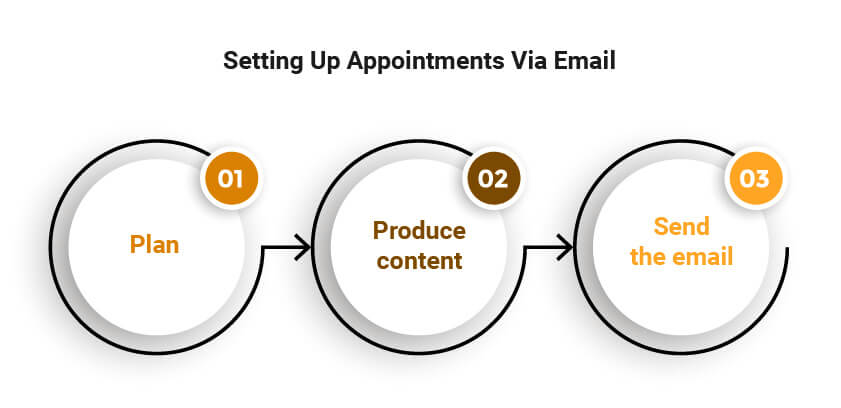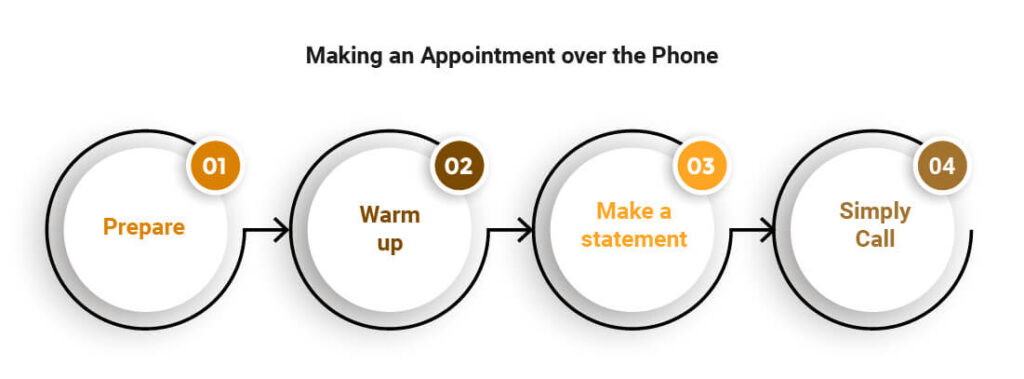
Performing in-depth research, constructing ideal customer profiles (ICPs) and buyer personas (BPs), hand-picking leads, creating personalized content for a multichannel outreach, calling, emailing, tracking various KPIs, performing analysis, and finally starting all over again are all part of the B2B outbound lead generation process. But wait, did we leave something out?
Yes, the goal of this procedure is to schedule a B2B sales appointment.
Back in the day, the salesperson was mostly responsible for all of the jobs. We prefer to divide and conquer now that sales specialization has evolved. Sales executives (SEs) are in charge of selling and completing transactions, while appointment setting has become the new currency of sales development reps (SDRs).
What Is B2B Appointment Setting?
Table of Contents
B2B appointment setting is a sales process that involves contacting potential buyers via several channels (phone, email, and social media) and qualifying and nurturing them in order to establish an appointment.
Setting appointments aids in the expansion of your sales funnel and the expansion of your firm. Appointment setters are in charge of this procedure and often work as sales development representatives (SDRs). Learn more about appointment setters like Only B2B and the abilities required to succeed in the SDR industry.
When a meeting is scheduled, the focus shifts to sales professionals, whose duty it is to transform that meeting into a closed contract.
Must Read: Sales Success Secrets: The Critical Role of Lead Generation and Appointment Setting
Setting Up Appointments Via Email
One of the most efficient ways to reach out to new clients is by cold emailing. A cold email is an initial email sent to recipients without any prior contact in order to initiate a business dialogue. Behind one sales email, there’s a lot of science at work.
Furthermore, it is 40 times more successful than Facebook and Twitter combined in attracting new clients. Do not, however, misunderstand the notion of cold emailing; it does not indicate that you will be able to schedule an appointment with the first email you send.
What Are The Best Ways To Schedule Appointments Through Email?
To effectively set up an appointment with a prospect, follow these three steps:

Plan
Sending a few emails to book that appointment is part of the planning process. This entails devising a cold email approach as well as deciding on wave lengths and cadences. We recommend three to five waves separated by at least a few days.
Produce Content
You may now begin working on the actual text of your emails. A subject line, opening line, sales pitch, closing line, and signature make up a cold email. When copywriters build email templates, they always give room for personalization so that the message seems tailored to the recipient.
Send An Email
After personalizing the email, the SDRs send it out according to the recipient’s time zone.
The better your emails are, the more opportunities you’ll have to schedule an appointment. Personalize, humanize, and add value to your emails. They must be sent at the appropriate time and day, as well as to the appropriate individual. You’ll be able to schedule an appointment via email if all of these puzzle pieces fit together.
Making An Appointment Over The Phone
Another technique to set up an appointment is to call, and in the case of lead generation, cold calling is to blame. Cold calling is a touchy subject: some think it’s the finest method to reach out to prospects, while others argue it’s no longer effective. We believe it is neither.
When paired with other sorts of outreach to warm it up, cold calling is quite successful (cold emailing, social media messaging, ads, etc.). It does, however, take some perseverance—most salesmen stop up after a few failed efforts to contact a prospect over the phone.
Must Read: B2B Appointment Setting In A Nutshell
What Are The Best Ways To Schedule Appointments Through Phone?
To set up more appointments with prospects, use these four cold calling techniques:

Prepare
Professional researchers know where to look for current and reliable information, including phone numbers. Finding the straight path that links directly to the lead while bypassing the gatekeeper is suggested.
Warm Up
It’s a good idea to warm up your connections before commencing the outreach. Cold calling and cold emailing work well together, making a multichannel strategy particularly effective.
Make A Statement
SDRs need to know what they’re going to say before picking up the phone. They must be completely aware of the value offer, employ customization, and have a calling script in their hands in order to do this.
Simply Call
Asking for an appointment over the phone may be a stressful experience. But don’t be concerned. You’re more likely to succeed if you have a decent lead, a message to warm it up, an appointment establishing script, and some personalization in your bag of tricks.
Scripts For Appointment Setting
You never know what may happen while making an appointment over the phone. The prospect’s tone, style of speaking, or inquiry may throw you off. You should always have an appointment setup script on hand to guarantee that you don’t lose your capacity to communicate.
Appointment setting scripts are useful for training SDRs, dealing with call resistance, controlling the discussion, preparing for the next call, delivering the value offer, and imparting confidence in the SDR.
The best appointment setting scripts usually involve:
Must Read: 5 Signs It’s Time to Outsource B2B Appointment Setting

Introduction
To establish a rapport, the beginning of a discussion, including greetings, is critical. Conversation openers that state who you are and what company you represent are available in a well-written script. Because a cold call isn’t a monologue, we recommend using breaks in your speech to allow prospects to converse.
FAQ (Frequently Asked Questions)
So, what exactly do you do? What sets you apart from your competitors? How much does it set you back? The perfect glossary sitting on your desk is a compilation of solutions to these inquiries.
Questions For Pre-Qualification
Before you schedule a meeting, determine if you’re dealing with a qualified lead—someone who is likely to progress through your sales funnel.
Proposition Of Value
It’s the most important part of your pitch. You must clearly demonstrate why your service can make a difference and tailor your pitch to the needs of your target audience. Make your message more about them, and provide value to the conversation at all times.
Setting Up An Appointment
All of the preceding advice has led up to this point. If you’ve had a good conversation with a prospect, now is the time to talk about the next steps. This can be accomplished by either following up (in the event that further information is required) or by making an appointment.
Appointment making scripts will not perform all of the work for you, but they will assist you in connecting with the person on the other end of the line. To engage the reader, use your value proposition, personalization, and copywriter’s content. It’s also beneficial to have a resource that lists typical concerns and solutions.
Above all, pay attention and be human. Use cold calling scripts to assist you get through the pitch if you need some guidance.
When Is The Best Time To Schedule Appointments?
The task of the SDR is done once the appointment is made, but there is more you can do to reduce the danger of a no-show for your sales executives. While there is fixed time of week that will work for all of your prospects, there are several time periods you should avoid.
The worst time to plan a meeting, according to Salesloft, is between 8 and 10 a.m. The rate of no-shows is greatest during these three hours. Setting appointments, on the other hand, is best done at the end of the day, between 3 and 5 p.m.
In terms of weekdays, the same study found that Mondays and Wednesdays have the lowest no-show rates, while Friday has the highest.
In general, avoid Monday mornings and Friday evenings; individuals are frequently preoccupied with other plans at these times.
Conclusion
Lead generation, lead qualifying, lead research, targeting, and appointment setting are all sales specialties that need a significant amount of effort to learn.
Even though we’ve gone through the finer elements of what B2B appointment setters do, how appointment setting works, different methods to ask for appointments, and even the tactics that have helped us succeed, it’s still not the same as doing it professionally.
So, if you’re looking for some experienced professionals to work on appointment setting for your company, you know where to find us.
Must Read: Difference Between Lead Generation And Appointment Setting With Benefits.

Vikas Bhatt is the Co-Founder of ONLY B2B, a premium B2B lead generation company that specializes in helping businesses achieve their growth objectives through targeted marketing & sales campaigns. With 10+ years of experience in the industry, Vikas has a deep understanding of the challenges faced by businesses today and has developed a unique approach to lead generation that has helped clients across a range of industries around the globe. As a thought leader in the B2B marketing community, ONLY B2B specializes in demand generation, content syndication, database services and more.


